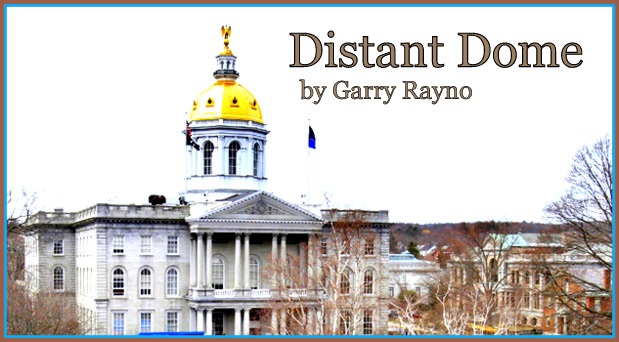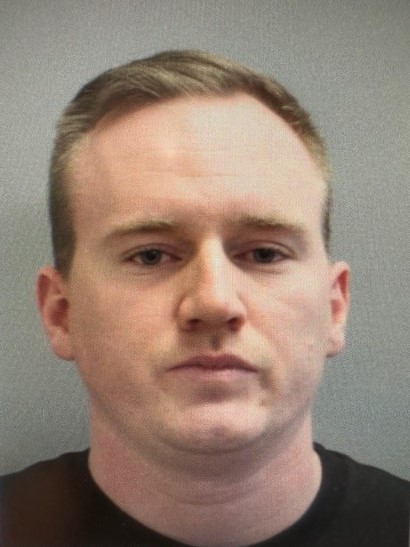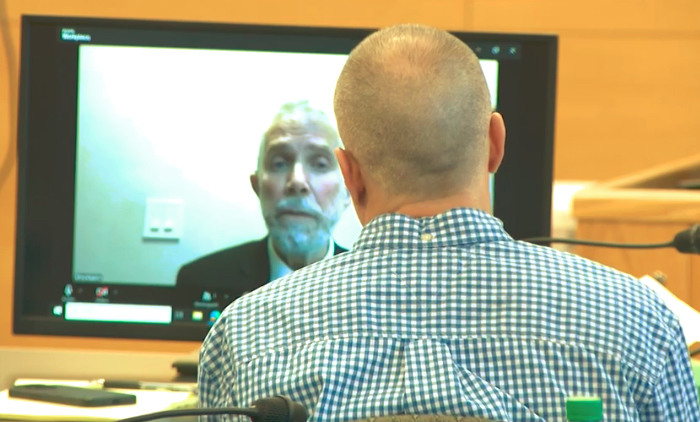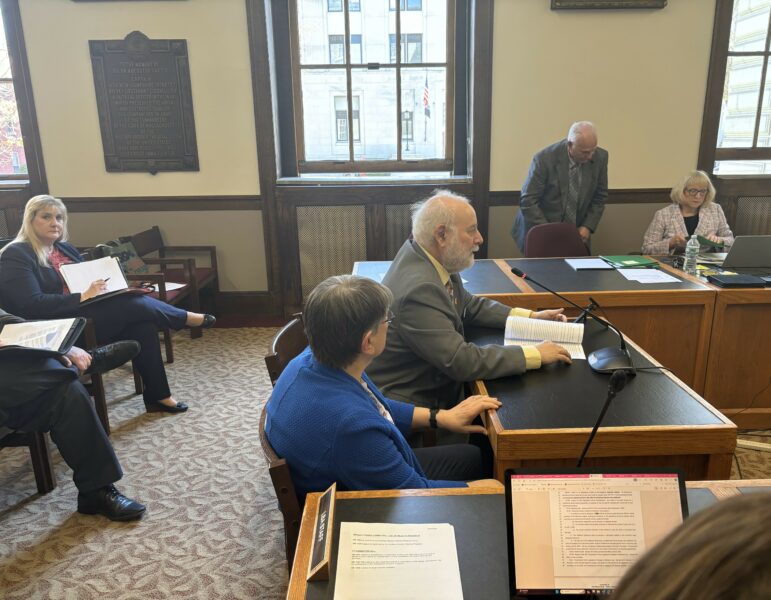
By GARRY RAYNO, InDepthNH.org
One thing to remember is when governors give their budget address, that will be the rosiest financial picture you will see for the next five months.
Most governors put their budgets together with chewing gum and baling wire. Reality hits when the House Finance Committee begins its work on the more than 1,300-page budget document.
The other thing you can count on is hearing members of the governor’s opposing party say, “the devil is in the details.” The details emerge when budget writers on the House Finance and Ways and Means committees begin work on the budget that needs to be in place July 1.
Not only do governors always present the best possible scenario, they always say their budget proposal is not political but of course they are. Democrats and Republicans have different fundamental priorities and areas of government are treated differently depending on the governor’s party.
What Gov. Chris Sununu presented Thursday was a budget that did not overreach, and instead largely maintains existing programs at mostly current expenditure levels.
The governor presented a two-year operating budget of $13.8 billion of total funds, a 5.6 percent increase over the current budget ending June 30, but general and educational fund spending was $41 million less than the current biennium approved budget at $5.45 billion.
That is the first decrease in the general fund budget since the fiscal 2012-2013 budget driven by major revenue shortfalls from the Great Recession and a hefty bill sent from the federal government over the state’s Medicaid program hospital reimbursements.
Sununu’s budget proposal includes hefty revenue projections that would increase 5.5 percent over the current budget plan.
And he would use about $30 million of the state’s $115.5 million rainy day fund to balance the current biennium’s budget which is projected to have a $50 million deficit.
The governor’s boost in revenues comes as he wants to cut taxes for businesses, investors and retirees and tourists, whether native Granite Staters or from some foreign state or country.
Coming out of a recession, logically state tax revenues would increase and the rooms and meals tax should improve noticeably from receipts over the last 12 months when people stopped eating out and traveling. In the current budget year, rooms and meals revenues are down more than 22 percent from what the state was projected to receive from the levy.
Quirks in the state’s revenue stream not anticipated a year ago make analysis of revenues different.
Business taxes tanked at the end of the last fiscal year mostly due to date changes at the state and local level, but since then have performed much better than anticipated, as have the real estate transfer tax, tobacco tax and interest and dividends tax.
Sununu’s revenue projections increase business tax revenues although he wants to cut the rate of the business enterprise tax, the one that hits the state’s small businesses more than major corporations and wants to raise the threshold for filing and paying the tax.
His revenue projections show a projected increase of $20 million for business taxes in fiscal 2022 and another $21 million increase in 2023.
Sununu did not propose lowering the rate of the business profits tax, mostly paid by large multi-state or international corporations which have thrived despite the pandemic.
Sununu is also proposing to cut the interest and dividends tax and eliminate it over five years, yet his revenue estimates include a $7 million increase in 2022, before dropping $4 million in 2023, which would indicate the rate cut would not come until the last year of the next biennium.
Sununu wants to cut the rooms and meals tax by half a percentage point but is projecting a $13 million increase in 2022 and a $21 million increase in 2023, but that figure, $344 million, is still $40 million below what budget writers projected the tax to produce this fiscal year, $386.9 million.
Federal Money
While Sununu’s budget will spend less general fund or state tax money, it spends a greater amount of federal funds than was projected this budget cycle.
For the current biennium, federal funds total $3.928 billion, but for the next biennium the state is projected to receive $4.474 billion from the feds, a $446 million increase, or 11.4 percent.
Much of that increase in federal funds is for the Department of Health and Human Services. While Medicaid expenses are essentially flat over the next two years in the proposed budget, New Hampshire Hospital costs are projected to increase by $15 million in 2022 and $6 million in 2023.
Federal funds represent 32 percent of the total spending from all funds, while the general funds account for 25 percent of all revenues.
Curiously, Sununu talked about improving child protection services during his budget address, but his budget reflects a drop in spending currently $138.7 million, which would go to $107.4 million in 2022 and $112.1 million in 2023. Child development would see a similar droop from $40 million this fiscal year to $31.9 million in 2022 and $31.8 million in 2023.
There may be a good reason for that, but House Bill 2, which contains the changes in statutes needed to correspond to the numbers is not expected to be released until later this week.
County Costs
While Sununu made a point to say his proposed budget does not downshift costs to cities and towns, instead sending more money through the rooms and meals distribution in revenue sharing, his budget would shift some nursing home costs to county, i.e. property taxpayers.
Under an agreement between the counties and state several decades ago, counties pick up a larger share of the county nursing home costs and in return the state picks up a larger share of juvenile services costs.
The agreement caps the costs for counties, but the cap has changed over time depending on the state of the state’s finances.
In his proposed budget, he eliminates $3 million in provider payments the state paid this fiscal year and reduces the general fund obligation to cover other costs from $29 million this biennium to $10 million in the new one.
Those are costs that will be obligations for the counties which are funded by property taxes.
Higher Education
Sununu is proposing combining the university and community college systems, saying with declining enrollment and the pandemic, the 11 facilities would better respond as a group instead of competing with one another.
Combining the two systems would also mean less money for both in his proposed budget.
Currently the University System of New Hampshire and the Community College System of New Hampshire receive $295.6 million in state funds for the current biennium.
Sununu’s budget would give the two systems combined $278.8 million, a reduction of $17.6 million from what they received this biennium.
In their budget requests to the governor, the two systems sought $307 million, $28 million more than Sununu proposes.
Municipal and Education Aid
While the governor’s proposed budget includes about $15 million in new revenue sharing for cities and towns, but does not include the $20 million a year included in the current biennial budget.
The current budget also included $50 million in education disparity aid for property poor communities and an additional $12.5 million to help communities with high poverty levels.
Neither aid program appears in Sununu’s proposed budget. The money was one-time money to be distributed during the current fiscal year.
School districts are facing a $90 million shortfall in state aid for the upcoming fiscal year due to lower enrollment, and a federal change in the free and reduced lunch program.
Sununu said the state would make sure no school district is left behind because of the free and reduced lunch change but did not say the state would adjust state aid to offset the loss due to dropping enrollment due to the pandemic.
Medicaid Rate Increase
During his budget address, Sununu said he would continue with the 3.1 percent increase for Medicaid providers.
The current budget included two 3.1 percent rate increases for Medicaid providers.
The second rate increase actually began Jan. 1.
The House has an April 8 deadline to act on its budget plan and the Senate has until June 3 to act on its plan. A conference committee on the budget has to finish its work by June 30 when the current budget ends.
The two-year budget plan that emerges in June will reflect Sununu’s proposal, but will have many, many changes.
Garry Rayno may be reached at garry.rayno@yahoo.com.
Distant Dome by veteran journalist Garry Rayno explores a broader perspective on the State House and state happenings for InDepthNH.org. Over his three-decade career, Rayno covered the NH State House for the New Hampshire Union Leader and Foster’s Daily Democrat. During his career, his coverage spanned the news spectrum, from local planning, school and select boards, to national issues such as electric industry deregulation and Presidential primaries. Rayno lives with his wife Carolyn in New London.
InDepthNH.org is New Hampshire’s only nonprofit, online news outlet dedicated to reporting ethical, unbiased news and diverse opinions and columns.





